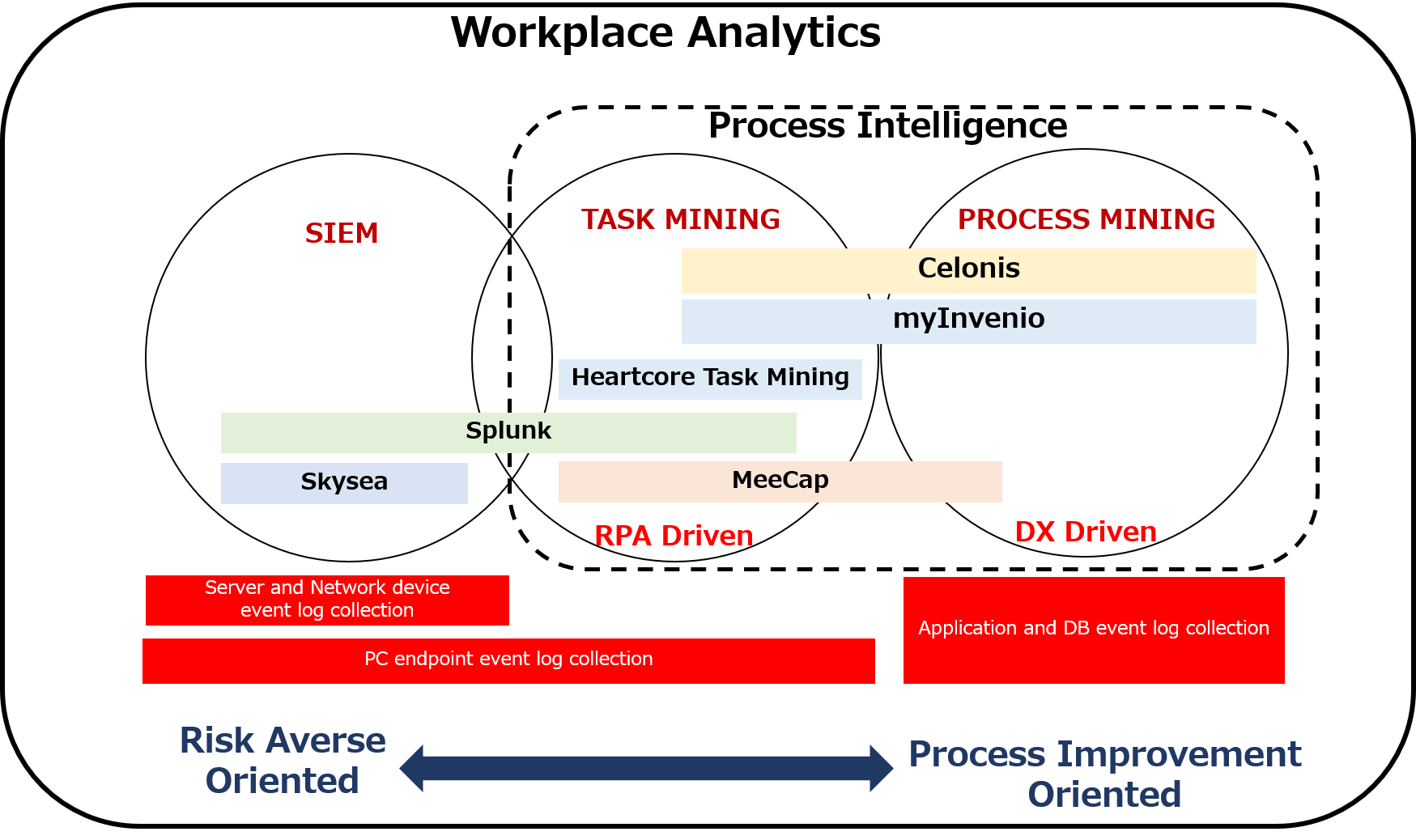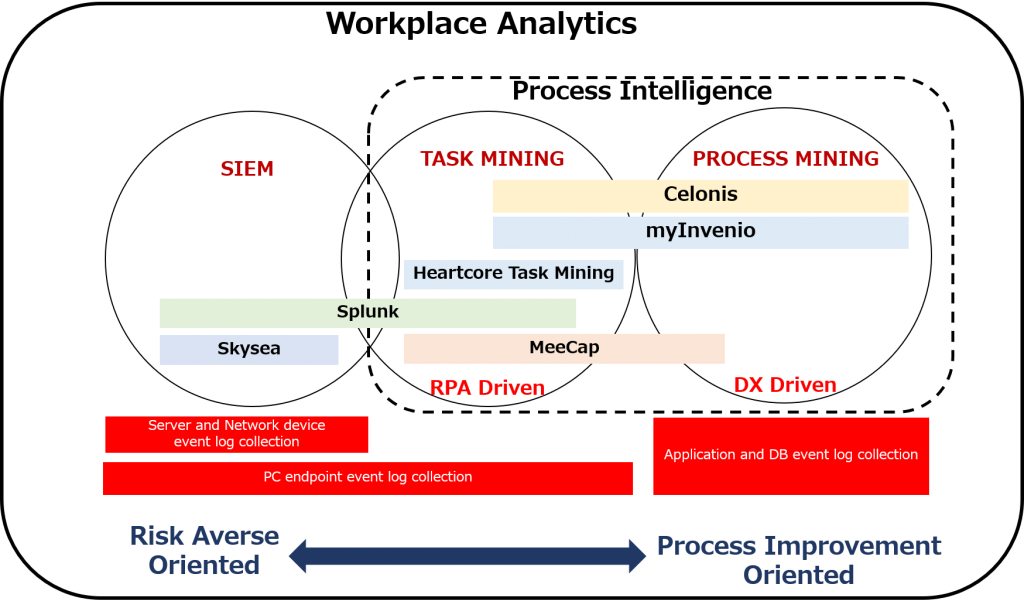Positioning of process mining-related tools from Workplace Analytics perspective
English follows Japanese. Before proofread.
「プロセスマイニング」は1990年代末に誕生し、昨年、20歳の誕生日を迎えたばかりの新しい分析手法ですが、2019年には新たに「タスクマイニング」という概念が登場しました。
当記事では、プロセスマイニング、タスクマイニングに、これらのソリューションと類似のソリューションである「SIEM:Security Information and Event Management」を含めて、狙いや位置づけの違いを整理整頓してみたいと思います。
まず、プロセスマイニングとタスクマイニングの違いについて。簡単に説明するなら、分析対象となるデータが異なります。
プロセスマイニングは、ERPやCRM、SFAなどの業務システムに記録・蓄積されたイベントログ(トランザクションデータ)を抽出したものが分析対象です。記録されているデータは、「購買申請」、「購買承認」など、システムの「送信」や「更新」ボタンを押下したタイミングの活動が基本で、業務の「節目(マイルストーン)」だけの粒度の粗いものです。
一方、タスクマイニングは、従業員が各自操作するPC上での詳細な操作、具体的には、アプリの起動、ファイルオープン、マウスクリックやコピー&ペーストなどが記録された「PC操作ログ」が分析対象となります。業務システムから抽出されたイベントログと比べると、これ以上分解できない「アトミック(原子的)」な詳細データであり、タスクレベルでの分析が可能です。なお、こうしたPC操作ログは、どこかに記録されているものではないため、分析対象となるPCに、センサー、あるいはエージェントと呼ばれるソフトをインストールして、能動的にPC操作をデータとして捕捉、収集サーバに蓄積する仕組みが必要となります。
プロセスマイニング、タスクマイニングに隣接した類似ソリューションに「SIEM」があります。これは、セキュリティ機器、ネットワーク機器、およびサーバに残されている各種ログを分析することで、サイバーアタック、データ漏洩などのセキュリティに関わる問題を発見する、また、IT機器の資産としての管理を行う、といったことが目的になります。
さて、これらのソリューションは、基本的に「職場(ワークプレイス)」で発生しているデータを分析することから、大きくは「ワークプレイスアナリティクス(Workplace Analytics)」という枠組みに入れることができるでしょう。
それでは、ワークプレイスアナリティクスの枠組みで、プロセスマイニング、タスクマイニング、SIEM、およびそれぞれのキーソリューションを位置付けてみましょう。(下図参照)
図の下部の両矢印あたりをご覧ください。プロセスマイニングは「プロセス改善志向」であり、一方、「SIEM」は、「リスク回避・管理志向」です。タスクマイニングその中間に位置しています。なぜなら、タスクマイニングでは従業員の日々の業務内容全体を把握できるため、勤怠管理にも活用できるからです。(プロセスマイニングは、業務システム上で行われた操作だけのデータが分析対象のため、一日の業務全体を把握することはできません)
また、プロセスマイニングとタスクマイニングは、「プロセスインテリジェンス」という枠組みで囲むことができますが、SIEMは、「プロセス」を分析対象とはしていないため、含まれません。
そして、プロセスマイニングは、企業全体のプロセス改革やデジタルトランスフォーメーション(DX)の視点からのアプローチに有効であることから「DX志向」、一方、タスクマイニングは、最終的にはタスクレベルでの自動化であるRPAを目的とすることが多いため、「RPA志向」と言えるでしょう。
では、それぞれのカテゴリーのキーソリューションを見ていきましょう。現時点(2020年2月)において、日本のプロセスマイニング市場のキープレーヤーは、CelonoisとmyInvenioの2つ。両ツールとも豊富な機能と優れた操作性を備えたエンタープライズソリューションであり、大企業を中心に導入企業が増えています。そしてつい最近、両ツールとも「タスクマイニング機能」を追加しています。業務システムからのイベントログデータだけでなく、PC操作ログからのフローチャート(プロセスモデル)も作成可能とすることで、タスクレベルでの自動化を目指すRPA化に必要な分析ニーズに対応したものだと言えるでしょう。
タスクマイニングのカテゴリーでは、myInvenioの日本総代理店であるハートコアが、「Heartcore Task Mining」を提供。また、銀行業界を中心に導入実績のある「MeeCap」は、ERPなどからのイベントログも分析するプロセスマイニング機能へと拡張を始めています。
SIEMカテゴリーでは、Splunkや、Skysea Viewが知られていますが、SPlunkが、プロセスのフローチャート機能を追加してきています。ただし、イベントログを取り込んだ分析までは行えないようです。
以上、ワークプレイスアナリティクスの枠組みでプロセスマイニング、タスクマイニング、SIEMの目的や位置づけを整理整頓してみました。
職場の業務改革のための各種ソリューション比較検討の参考になれば幸いです。
“Process mining” was born in the late 1990s and last year turned 20 years old. In 2019, a new concept called “task mining” appeared.
In this article, I would like to organize and sort out the differences in purpose and positioning, including “SIEM: Security Information and Event Management”, which is a similar solution to process mining and task mining.
First, the difference between process mining and task mining. In simple terms, the data to be analyzed is different.
Process mining analyzes the event logs (transaction data) recorded and accumulated in business systems such as ERP, CRM, and SFA. The recorded data is based on activities such as “purchase request” and “purchase approval” when the “send” or “update” button of the system is pressed, and the granularity of only the “milestone” of the business Is a rough thing.
On the other hand, task mining analyzes the detailed operations on PCs that employees operate individually, specifically, the “PC operation log” that records application launches, file opens, mouse clicks, copy and paste, etc. Eligible. Compared to the event log extracted from the business system, it is “atomic” detailed data that cannot be further decomposed and can be analyzed at the task level. Since these PC operation logs are not recorded anywhere, install software called sensors or agents on the PC to be analyzed and actively capture and collect PC operations as data. A mechanism to accumulate on the server is required.
“SIEM” is a similar solution adjacent to process mining and task mining. It analyzes security logs, network devices, and various logs remaining on servers to find security-related issues such as cyber attacks and data leaks, and manages IT devices as assets. And so on.
Now, since these solutions basically analyze data generated in the “workplace”, they can be broadly put into the framework of “Workplace Analytics”.
Now let’s position process mining, task mining, SIEM, and their key solutions within the framework of workplace analytics. (See the figure below)
Look around the double arrow at the bottom of the figure. Process mining is “process improvement oriented”, while “SIEM” is “risk aversion and management oriented”. Task mining is located in the middle. This is because task mining can be used for attendance management because it allows you to understand the entire daily work of employees. (In process mining, since only the data of operations performed on the business system is the analysis target, it is not possible to grasp the entire business of the day.)
In addition, process mining and task mining can be surrounded by the framework of “process intelligence”, but SIEM is not included because “process” is not analyzed.
And process mining is “DX-driven” because it is effective for process reform of the entire company and approach from the viewpoint of digital transformation (DX), while task mining is ultimately an automation at the task level Because it is often aimed at a certain RPA, it can be said that it is “RPA-driven”.
Let’s look at the key solutions in each category. At this time (February 2020), two key players in the Japanese process mining market are Celonois and myInvenio. Both tools are enterprise solutions with rich functions and excellent operability, and the number of enterprises, especially large enterprises, is increasing. And recently, both tools have added a “task mining function”. By being able to create not only event log data from business systems, but also flow charts (process models) from PC operation logs, it can be said that it meets the analysis needs necessary for RPA to aim for task-level automation Will be.
In the task mining category, heartcore, myInvenio’s sole agent in Japan, provides Heartcore Task Mining. In addition, MeeCap, which has a track record of introduction in the banking industry, has begun to expand to a process mining function that analyzes event logs from ERP and other sources.
In the SIEM category, Splunk and Skysea View are known, but Splunk has added a process flowchart function. However, it seems that analysis cannot be performed until the event log is imported.


